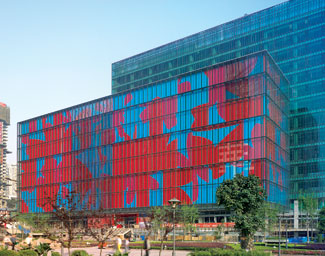Sound Off 1: Hendrix on 'Sustainable Design'
 “Sound Off” is an op/ed post by editors of the Tricycle blog. The opinions may or may not reflect those of the Company.
“Sound Off” is an op/ed post by editors of the Tricycle blog. The opinions may or may not reflect those of the Company.
Tricycle is a sustainable design company. What to make of this unfamiliar phrase, sustainable design, that's plastered on our front door, ready to trip people up when they come to visit? Is it industrial design, graphic design, interior design, technology design, product design? All of the above?
For an answer, let's reframe the question. Because sustainable design is a new category in the professional world, in which a design company is defined not by its output but by its objectives. Tricycle's creations help create sustainability. Things, processes, programs, education, materials, etc... our means are varied, but there is a single goal of creating economic, environmental and social profitability on a long-term view. We improve processes, change corporate cultures, introduce efficiencies, identify wastefulness, improve communication, create wealth. We do it by integrating into established manufacturing processes, marketing mechanisms and purchasing cycles; deep dives in are what produce change, otherwise it's just more treading water.
So yes. On staff we have graphic designers, industrial designers, an interior designer and product designers, as well as code developers, accountants, engineers, print specialists, even the odd English professor and theologian (and we do mean odd). Just this week, this mish-mash of creative input resulted in our company profile being rejected from a sustainable graphic design blog because Tricycle is not “exclusively graphic design.” As a holder of a BFA in Graphic Design (which I teach, practice and promote), this gave me pause. And led me to think about the origins and nature of our company, as well as of this new category of sustainable design.
One of my primary reasons for co-founding Tricycle was the search for a career with greater meaning and social significance. I had practiced graphic design in its traditional form for seven years. Increasingly, I found piecemeal design projects to be unsatisfying, as I watched the growth of desktop publishing empower laymen to do unspeakable things with type and layout software. Inspired by a Charles Eames diagram, I believed it possible to change the way design works, to the benefit of the designer, client and larger society. I met three like-minded people; our skill sets, experience and geography positioned us to change a local industry... carpet manufacturing... on a grand scale.
I am certainly not alone in this new “design thinking”. Last year, the AIGA executive board expressed a new belief in design's ability to engage culture and commerce effectively in today's marketplace. The world of Paul Rand and Lester Beall had moved on, but many graphic designers had not. As a result, AIGA redefined itself, going so far as to drop the “Graphic Arts” reference from its name, opting instead for a tagline: “The Professional Association for Design.” The organization's mission statement was revised to “to further excellence in design as a broadly defined discipline, strategic tool for business and cultural force.” A group that was once primarily focused on aesthetics and networking keyed in to the fact that design's most influential power lies in its process. Looking good (aesthetic quality) is simply a given. I believe that this shift in the understanding of my profession is well-founded. Not only will it help advance graphic design, as more cross-disciplinary firms come to the forefront it will break new ground. For instance, SOM, rock stars in the interior and architecture design world, won this year's only graphic design Gold in the prestigious 85th Annual Art Directors Club awards, for their graphics for the Jianianhua Center. The disciplines in the design profession are merging because designing for various media require the same approach to problem solving and today's technologies, as well as the proliferation of more skilled designers, make it easier.
I believe that this shift in the understanding of my profession is well-founded. Not only will it help advance graphic design, as more cross-disciplinary firms come to the forefront it will break new ground. For instance, SOM, rock stars in the interior and architecture design world, won this year's only graphic design Gold in the prestigious 85th Annual Art Directors Club awards, for their graphics for the Jianianhua Center. The disciplines in the design profession are merging because designing for various media require the same approach to problem solving and today's technologies, as well as the proliferation of more skilled designers, make it easier.
The implications for sustainability, and for sustainable design, are huge because graphic designers are moving out beyond the basics. Today's graphic design industry is much like architecture during the early days of the USGBC’s LEED initiative. In its infancy, everyone was focused on the material content of products... e.g. recycled content vs. virgin content. Today's LEED's focus has expanded to include manufacturing processes, life cycle, performance and disposal... and is expanding still. As the idea of “design thinking” matures in my own profession, I believe the scope of what constitutes sustainable design will grow to include relevancy and necessity. In many firms it already does. I think it does at Tricycle.
Sustainable design is a process-oriented practice, concerned with the full life cycle of "stuff." Part of that life cycle includes marketing and aesthetics... the most obvious point where the craft of graphic design plugs in. I believe, and believe that AIGA and USGBC would agree, that designers have much more to offer than specifying a green product. It is not enough to design a nonprofit brochure on recycled paper or to specify a Cella chair, then claim environmental responsibility. It is time to rethink and redesign the life cycles of products, the processes of the businesses that make them, and the channels to market. This is how we design a sustainable society.
R Michael Hendrix is co-founder and Chief Brand Officer of Tricycle, Inc.
1 comment:
One word, 'Smarticulate'.
Thank you Michael, I enjoyed your article.
May all the world catch on befo' we all catch on fire!
Post a Comment